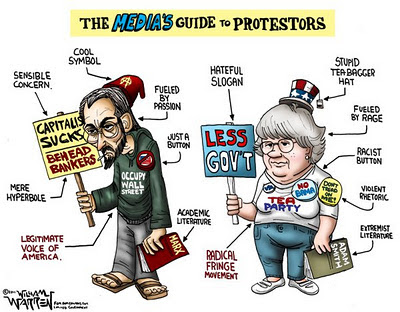Oh, you “Occupiers” love a good story or theme, even if it’s complete BS.
Let’s look at how “Wall Street” or “Big Banks” have destroyed the economy.
The protesters and resulting media outlets like to discuss how the “99%ers” bailed out Wall Street and it cost us so much. Let’s set the facts straight. As per the NY Times, $550bn was committed in TARP funds to “bail out the banks.” $175mm was used for banking institutions. Of all the “Big Banks,” not only was the money returned, but the Treasury MADE Money on the transaction. In fact, in April 2009, a number of financial institutions TRIED to repay the TARP loans and were denied by the Obama administration. However, starting later in 2009, banks began repaying the funds. For example, Bank of America, which received $45bn, paid back the $45mm and paid $3bn in interest, or a 6.67% absolute return – well above the rate they borrow money from the Federal Reserve. Additionally, BofA had to grant Treasury warrants which they sold to “Wall Street.” As per the Washington Post, “The Treasury Department said Thursday that it sold its warrants to buy Bank of America stock for $1.54 billion, fetching a much higher price than what market analysts and federal officials expected.”
In August 2009, Slate wrote this, “As we approach the one-year anniversary of the Panic of 2008, it's clear that the actual cost of the TARP will be a fraction of the original $700 billion estimate and that taxpayers are even turning a profit from the central component of the package.” Less than a month later, the NY Times wrote, “Even as voters rage and candidates put up ads against government bailouts, the reviled mother of them all — the $700 billion lifeline to banks, insurance and auto companies — will expire after Sunday at a fraction of that cost, and could conceivably earn taxpayers a profit.”
The banks that have not yet repaid TARP – mostly local community banks – hardly would be classified as “Fat Cats,” but rather George Baileys (or at least the modern versions).
The Treasury wasn’t alone in its bailout funds. The Fed acted in a number of capacities also to stabilize markets. I haven’t tracked it closely, buy in the fiscal year 2009, they made a profit of $45bn on their stabilizing activities. I can only imagine they made more in 2010.
Yet, TARP will likely lose money and cost the taxpayers billions. The source of that loss, the bailout of GM and Chrysler – An action the Bush administration opposed, but the Obama administration approved. Per CNN, GM and Chrysler received $80bn in TARP funds. How much has been paid back? $2.1bn. Instead, the US government owns 32% of GM, which in total is worth only $37bn at today’s prices. Chrysler went bankrupt. I don’t see anyone hanging signs at plants in Michigan asking for the scalps of Detroit’s finest businessmen.
Did a number banks play a role in the actions that lead to the actual need for TARP? – sure. Were they sinister and evil-minded in general? – hardly. Were there bad apples that used shady practices? – Always and everywhere. Were they the only ones, or even the root cause? – No. Was “Main Street” caught up in a greed bubble as it related to housing? – A wholehearted YES. Were some of those practices created in “Washington?” – Absolutely.
I won’t get into all of it here, but read what I wrote in 2008:
Low interest rates and easily available, cheap corporate credit were allowing companies (even ones with shaky balance sheets) to refinance and borrow at low rates. Stock valuations were high, and returns on bonds were quite low. On top of that, low volatility in the market reduced risk premiums on traditionally risky investments. Basically, proper returns on investments were becoming harder and harder to come by. Traditional institutional investors (pension funds, mutual funds, endowments, banks and hedge funds) sought new ways to improve their returns. It can be accomplished two ways: leverage or increase risk - or a combination of both.
Wall Street, as it always has, stepped up to create products that were in high demand. They expounded upon an idea called securitization. Essentially, a securitization pools a bunch of assets together and chops them up into different tranches. The theory involves a diversification risk. The highest tranches are the safest in that they take the last losses. It was a huge hit - higher returns from riskier assets but with less risk. Wall Street firms repackaged all kinds of assets: home mortgages, commerical mortgages, high yield bonds, investment grade bonds, airplane leases, etc. Wall Street was the conduit, not the originator. These firms are underwriting the securities on behalf of other institutions including the government sponsored entities, Fannie Mae and Freddie Mac. I don't want to blast the securitization process completely. Securitizations work - they provide higher returns with less risk if held through maturity. ..
Investors, seeking higher yields, were not only gobbling up these securitized bonds under the impression they couldn't lose, but they were suplementing their returns by adding leverage (using borrowed money to purchase securities). Those with the best cost of capital yielded the greatest advantage in these securities…
Bubbles and Panics are systematic problems. Wall Street is not without fault, but this is not a "Wall Street Fat Cat"-created problem. It began with the average American, was fueled by Congress mandating a need to subsidize low income home ownership, and its subsequent risks were highly underestimated by investors who were seeking better return for their institutional clients, who collect and allocate money for average Americans.(
http://sonofthelama.blogspot.com/2008/10/politico-b-s.html)
The systematic housing bubble used a willing Wall Street as the vehicle to propagate itself, but it was fed by everyday people, all across the country.
As noted in the Wall Street Journal today by Peter Wallison, one of the government’s Financial Crisis Inquiry Commission members, “the narrative that came out of these events—largely propagated by government officials and accepted by a credulous media—was that the private sector's greed and risk-taking caused the financial crisis and the government's policies were not responsible. This narrative stimulated the punitive Dodd-Frank Act—fittingly named after Congress's two key supporters of the government's destructive housing policies. It also gave us the occupiers of Wall Street.”
If any of these “occupiers” think JP Morgan, Citibank or Bank of America is responsible for their problems now, they are sorely mistaken. The fact that they have student loans they can’t afford, or don’t have high paying jobs being thrown at them, is not the fault of these institutions. “Wall Street” does not determine higher education tuitions. If anything, these institutions make getting student loans viable. “Wall Street” doesn’t determine who gets a job. If anything, they provide capital to the economy that allows companies to have funds for which to grow and expand and thus CREATE jobs. Every one of those “Occupiers” has a cell phone, an iPod, a digital camera, a social media account and pumped-up kicks that were each created because we have a capitalist system that finances those companies and allows them to grow. Additionally, those “Wall Street” banks are creating and managing mutual funds and 401(k)s by identifying the right investments and putting money to work so that when Social Security completely collapses under its own weight, today’s workers won’t be destitute.
History doesn’t repeat, it rhymes. The individual John Pierpont Morgan (JP, himself) was demonized in the late 1890s, early 1900s. He was rich and envied. He was accused of market manipulation because he dominated corporate finance. At the height of Morgan's career during the early 1900s, he and his partners had financial investments in many large corporations and were accused by critics of controlling the nation's high finance. In both 1895 and 1907, the U.S. was struck by panics almost crippling the American economy. Major New York banks were on the verge of bankruptcy and there was no mechanism to rescue them. Historians have attributed the actions by J.P. Morgan personally as what saved the market and the economy. However, that never stopped enemies of finance from publicly flogging him and his business. In 1912, he was berratted in front on Congress. In 1920, a group of financial anarchists blew up a bomb on Wall Street loaded with 100 pounds of dynamite and 500 pounds of cast- iron slugs in front of J.P. Morgan headquarters. The bomb was aimed at the financial institutions related to postwar social unrest, labor struggles and anti-capitalist agitation in the United States. Thanks for keeping the industrial revolution alive – here’s a bomb for ya!
It was wrong in 1920 and still is today. Yet today we still blame “Finance” for our problems. The world, and Europe in particular, is gasping because governments spent beyond their means. Social programs, welfare states, giving away better jobs because people “deserved it,” state mandated wages and inflations were funded with debt that many of these countries could not reasonably afford. If we follow the path that many of these “Occupiers” espouse, we’ll be right behind Europe.
They should look to Washington as to where their tax dollars are being spent. If they think “green jobs” and tax rebates are getting the country back to work – by all means, keep supporting it. If they think robbing the “rich” is going to grow GDP and stimulate the creation of new jobs – by all means, fight for it. It’s wrong, but at least it’s a rationale discussion.
I saw a shirt today with a slogan that I now love.
I could agree with you, but then we’d both be wrong.




























